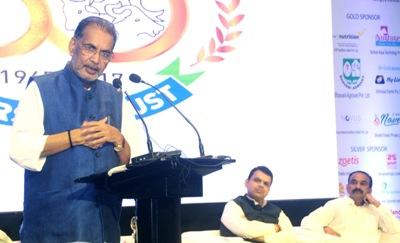Indian Agriculture and Farmers Welfare Minister, Radha Mohan Singh addressed a gathering at a seminar on Role of Animal Husbandry in Doubling Farmers’ Income, organised by the Compound Livestock Feed Manufacturers Association (CLFMA) on September 15, 2017, in Mumbai.
Speaking at the 50th CLFMA meet, Singh said that we are working to double farmers’ income by 2022, and this can be accomplished only by encouraging farmers to adopt other sources of income like Animal Husbandry, which has immense potential in the state of Maharashtra.
The Agriculture minister said that in the context of the topic of this seminar, in the absence of sufficient agricultural lands due to the natural geographical terrain of the state, farmers got many opportunities in other fields like poultry, dairy, fishery, bee keeping and animal husbandry.
Identifying strengths and weaknesses of animal husbandry sector is important to understand pro-poor policy steps and drawing up a comprehensive policy and its implementation plan, the minister stressed.
He said that we have to encourage farmers to diversify in allied sectors like horticulture, fisheries and livestock farming as it can help them in increasing their income. In addition, farmers should be technologically sound to understand the reforms introduced for their welfare. We also have to provide support to encourage them to adopt alternative farming.
The Minister said that agriculture and Animal Husbandry are interdependent and they grow together. The states like Chhattisgarh have benefited from diversification and other states have great potential too, and we should learn from those states and adopt their processes.
In order to promote agriculture sector, the Government has set up an ambitious target of doubling the farmers’ income by 2022. Several policies ranging from irrigation to crop insurance have been devised to accomplish the goal. However, if we have to change the food value chain, then we need to shift from production-oriented system to demand-oriented system, which quickly connects consumers with products.
He said to accomplish this goal, new approach and innovation would be necessary. In addition, food value chain will have to enhance the cooperation between private sector and other stakeholders. To make it work, an integrated value chain linking farm to the table is needed; Competitive markets is required to provide better value to the farmers; and a transitive environment to support innovation and action.
He said considering climate change and increasing pressure on land and water resources, it is not possible for a single stakeholder – be it governmental, corporate or from civil society – to accomplish it alone. We can make a difference by combining the competencies of diverse organizations and stakeholders and creating a better alignment through public private partnership platforms.
About Compound Livestock Feed Manufacturers Association (CLFMA)
Established in 1977 with 233 members, Compound Livestock Feed Manufacturers Association of India (CLFMA) represents the entire livestock, poultry and aquaculture industry in the country. This sector contributes 4% to the total GDP of the country and contributes 27% to the agriculture GDP. The poultry sector is an important driver of ensuring the protein security for the common man. It also provides livelihood to 20 million small and marginal farmers. The prime objective is overall development of Animal Husbandry by promoting balanced feeding of animals in accordance with their nutritional requirements for deriving the maximum output from them through productivity improvement.
Photo Caption: Indian Agriculture and Farmers Welfare, Radha Mohan Singh addressing at the Golden Jubilee Celebration of Compound Feed Manufactures Association (CLFMA), in Mumbai on September 15, 2017. The Chief Minister of Maharashtra, Devendra Fadnavis is also seen.























